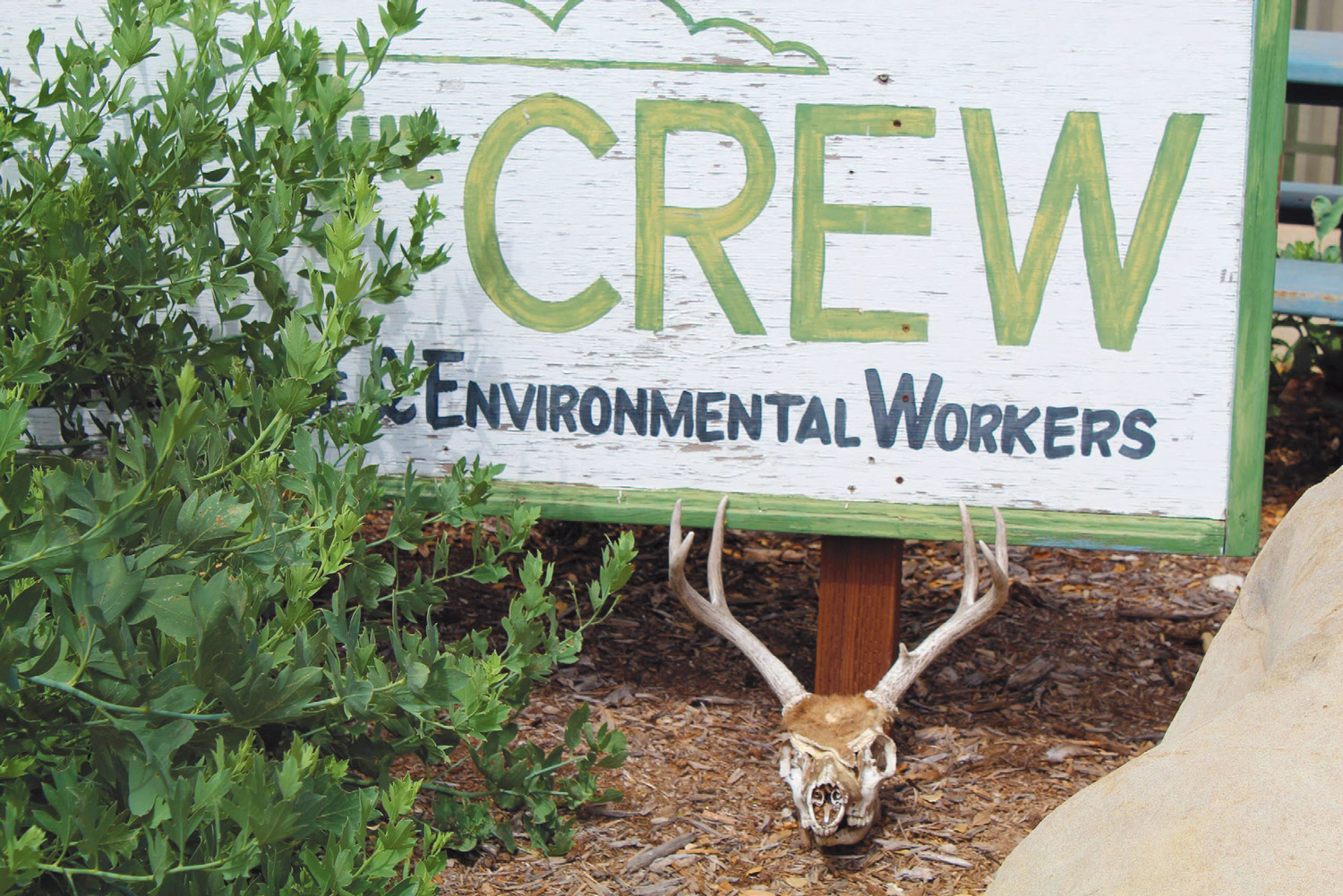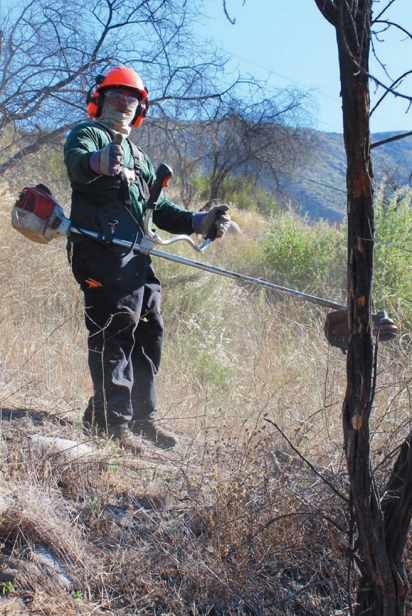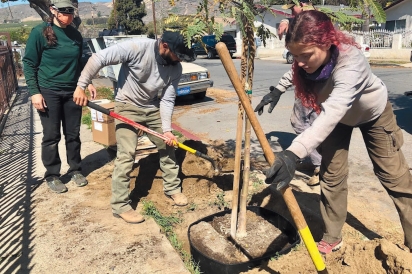Good Green Work for Local Youth
Anyone who has been to Ojai has witnessed its natural beauty, but local environmentalists say that much of the land in Ojai is not functioning the way it should. The native oak woodlands and savannas of Ojai are nearly gone, according to Caryn Bosson, and restoration is the only way to bring them back.
We lose biodiversity in the environment every time a native plant or animal species is no longer able to thrive in an area and becomes replaced by invasive non-native species. Restoration is about bringing back that biodiversity where it has been lost to make ecosystems healthy again.
Caryn has been a leader in nonprofits focused on the environment for many years. She is currently the community development director for The C.R.E.W. (Concerned Resource and Environmental Workers), an organization based in Ojai that gives young people ages 16 to 25 the chance to gain hands-on, paid work experience as crews for restoration, conservation, trail maintenance and fire prevention projects.
In 2020, The C.R.E.W. seized the opportunity of a special grant to focus even more on restoration and add another layer to the work crews they have been employing for 30 years. This fresh endeavor, the Green Valley Project, educates and empowers youth to take the lead on projects that restore Ojai’s landscape.
The Green Valley Project teams up local youth from as young as 13 to 25, educates them on environmental issues, gives them leadership roles and partners them with local experts to start taking action in their community. “We are putting young people at the center of restoration projects, and getting them on the pathway to restoring the ecosystems that have been lost in Ojai—really being caretakers for the environment,” says Caryn.
Its first project was to plant 36 oak circles in the Ojai Meadow Preserve along with staff, work crews and community partners of The C.R.E.W. such as the Ojai Valley Land Conservancy, Once Upon a Watershed, PAX Environmental and Watershed Progressive. By working together and involving youth, everyone feels that they can do more for their own missions.
The Green Valley Project attracts youth who are passionate about the environment, and guides them through choosing and completing restoration projects in their community, promoting those projects, encouraging the community to participate, and making sure that what they have accomplished is maintained.
TURNING PASSION INTO IMPACT
Tara Fay began her environmental journey in a similar way to many of the youth she leads now as project manager for the Green Valley Project. In high school, an enthusiastic teacher helped her discover her passion for the environment. At only 16, she joined the staff of her Boys and Girls Club and focused on leadership development for the kids there.
Tara went on to graduate from CSUCI with a degree in environmental science and resource management and worked for a short time in hazardous waste before her current role at the Green Valley Project. She is excited to be able to create clear paths for kids to use their passion to make an impact.
Green Valley Project offers a couple of in-depth ways for youth to get involved in environmental work and activism. The youth council takes on a specific restoration project related to pollinators, turtles or trees—the mascots of the Green Valley Project—and a team of communication interns handles the promotion and community outreach for that project.
“We bring like-minded youth together to become friends and leaders, and give them mentors for support,” says Tara. “When they realize there are other advocates out there, it helps the causes they want to tackle feel less overwhelming, and they start to believe they can make a difference.”
This summer, the inaugural cohort of the youth council began getting to know each other at a Green Valley Project “boot camp” held at City Hall. After electing officers, they chose a project from several options presented “Shark Tank”—style by partners such as Aja Bulla-Richards, local butterfly expert, and members of Ojai Trees.
They chose “Re-Oak Ojai,” which focuses on mapping out areas of Ojai that are in need of oak trees and offering residents free tree planting services (donated by Ojai Trees). The fall interns begin meeting in September and join the youth council on the project. The youth council meets bi-weekly and the interns meet weekly so that the project wraps up for both groups at the same time in November.
AMBASSADORS FOR THE ENVIRONMENT
Through experiences, planning and taking action toward the restoration of their own community, Green Valley Project participants become leaders and advocates for local ecosystems, and the pollinators, freshwater turtles and native trees that will help biodiversity return and flourish in Ojai.
Youth who are just beginning to learn about the environment get the chance to explore alongside botanists, biologists, ecologists and more, making their passion seem viable as a career path. Giving these youth the skills and confidence to educate and inspire their family and friends helps them create a legacy of stewardship.
Outdoor Saturdays are hosted by Green Valley Project twice a month to get the public involved in its efforts and give its interns and youth council members a chance to be leaders in their community. The events include maintaining restored areas with debris clean up and watering, guided hikes and classes on topics such as beekeeping or attracting pollinators.
Green Valley Project also offers a free spring science program for youth with hands-on outdoor experiments and experiences in the Ojai Valley, led by scientists from PAX Environmental, on topics such as birding, fisheries and botany.
Visit GreenValleyProject.org or follow @greenvalleyprojectojai on Instagram to find out more and get involved.
WHAT WE SHOULD CARE ABOUT!
Pollinators are active participants of biodiversity and give native plants the ability to adapt and recover from disease. Our landscapes depend on pollinators such as butterflies, bees, hummingbirds, moths and even wasps, flies, beetles, ants and lizards for fruit and seed production—especially in food crops. Pollinator populations have suffered a massive decline due to pesticides and loss of habitat.
The Southwestern Pond Turtle is the only native freshwater turtle in California and is listed as a species of special concern. These turtles play a crucial role in our local watershed ecosystems, controlling aquatic vegetation and scavenging dead animals and fish from the bottom of creeks and rivers to keep them healthy. These turtles are threatened by overdevelopment, limited habitat and competition from invasive non-native species.
Trees are more than just a beautiful part of the local landscape. They provide shade for shrubs to grow beneath them and are the habitats of many native birds and small animals. Trees also help reduce air pollution by absorbing carbon. Native species are most likely to thrive in our dry climate, but are threatened by drought, development and invasive, fast-growing tree species such as eucalyptus and Mexican fan palm.
Adapted from the Green Valley Project website.
The current Green Valley Project youth council is made up of 12 members ranging in age from 14 to 21. After their day-long “boot camp” at City Hall, complete with a yoga session led by the mayor and a tour of the Middle Stewart Canyon Creek Restoration Project, several of the members stuck around to share their thoughts with Edible OVC.
Myranda, age 19, was previously a communication intern for Green Valley Project, where she created fun social media posts to promote Outdoor Saturdays and educate the community. As an intern, she says she learned how to be more professional and frame things to catch people’s attention, but says being on the council will be less about promotion and more about doing.
CatieJo, age 17, says there is not any part of the environment she doesn’t like, but she is most drawn to the animal aspect and endangered species. She completed a portfolio for her AP photography course at the Turtle Conservancy in Ojai. She says the digital age makes it easier to spread information about the environment, especially with so many students getting involved, and says starting in your own community is a great first step, wherever you are.
Surya, age 14, really enjoyed seeing and learning about the nearby restoration area at the boot camp, and a presentation by Bryant Baker on identifying trees by their cones and seeds. He appreciates how versatile trees are and thinks they can be just as interesting as animals.
MacKenzie, age 19, says she first learned about the environment when she stumbled across a video of what life could be like in 50 years for our planet. It both scared and inspired her so she started researching the topic. She changed her major at CSUCI to environmental science and resource management and says she never will go back. She is a member of the Green Generation Club and enjoys studying coral reefs, climate change and environmental justice.
Alex, age 21, says he is excited to learn more about grant writing and public outreach, and how to distinguish between native and invasive plants. As an intern with the Ventura Audubon Society, he says spending time out in the environment helped him learn how birds carry seeds around in their habitats and the diversity of species in shorebirds. He currently attends Ventura College and plans to transfer to CSUCI to study biology.
Journey, age 15, says she has wondered whether she can pursue a career in the environment when the projects seem so huge and daunting. This is what is nice about being on the youth council, she says, because we set a very clear goal with a time frame and have a structured group to work with.











